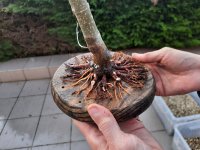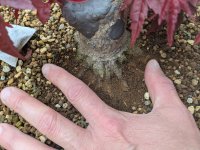Yannick81
Seedling
Good morning,
I wanted to show you guys how I'm developing Nebari (Acer Atropurpureum) in hopes to get some feedback on my approach.
I placed an upside-down petri dish into the soil at approximate depth of 1 inch. I placed the tree on top and waited until top level roots started gaining stability all around. Beginning of this season I cut off the lower level trunk where only submerged roots grew, forcing the tree to only sustain itself from ground level roots.
I gathered moss and placed it on ground level roots, hoping to keep the roots moist, but that didn't work. The tree is growing so I guess it wasn't the worst idea to build Nebari.
.
What do you think? Thanks.

I wanted to show you guys how I'm developing Nebari (Acer Atropurpureum) in hopes to get some feedback on my approach.
I placed an upside-down petri dish into the soil at approximate depth of 1 inch. I placed the tree on top and waited until top level roots started gaining stability all around. Beginning of this season I cut off the lower level trunk where only submerged roots grew, forcing the tree to only sustain itself from ground level roots.
I gathered moss and placed it on ground level roots, hoping to keep the roots moist, but that didn't work. The tree is growing so I guess it wasn't the worst idea to build Nebari.
.
What do you think? Thanks.







